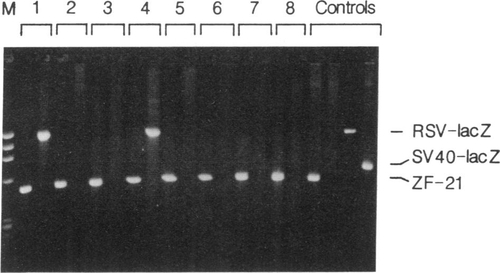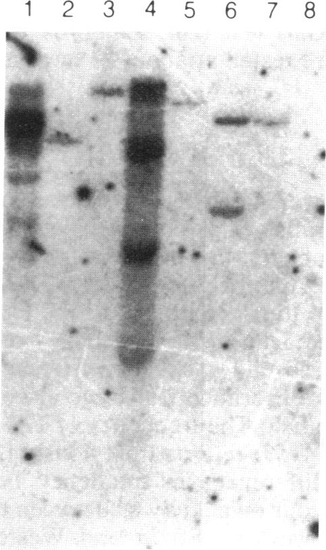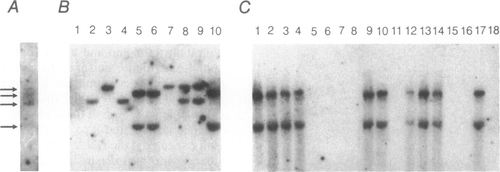- Title
-
High-frequency germ-line transmission of plasmid DNA sequences injected into fertilized zebrafish eggs
- Authors
- Culp, P., Nüsslein-Volhard, C., and Hopkins, N.
- Source
- Full text @ Proc. Natl. Acad. Sci. USA
|
Identification of germ-line transgenic fish by PCR. Genomic DNA was extracted from a pool of embryos from a single mating and was used in two PCR reactions that were run in adjacent lanes on a 2% agarose gel: samples 1-4 test genomic DNAs from embryo pools of four fish injected with pRSV-βGal, and samples 5-8 test pools from four pCH110-injected animals. The first lane in each pair is a positive control reaction containing primers from the zebrafish homeobox gene, ZF-21 (19), generating a 500-bp product; the second contains primers specific to the injected plasmids. The control lanes contain DNA from uninjected fish. The first control lane contains ZF21 primers, and the second, third, and fourth lanes contain both sets of primers directed to the injected plasmids. The third and fourth control lanes also contain 100 fg of the appropriate plasmid. Primers for fish injected with pRSV-/βGal generate a 1.2-kb product (third control lane), and the primers directed to pCH110 generate a 0.6-kb product (fourth control lane). Samples 1 and 4 demonstrate PCR amplification of the RSV-lacZ sequences and consequent germ-line transmission in these fish. Lane M: Hae III-digested OX174 size markers. |
|
Confirmation of transgenic fish by Southern analysis. Pst I digests of genomic DNA were subjected to Southern analysis by hybridizing with a probe from the lacZ gene (generated by using primers PC17 and PC18 in Fig. 1). Comparisons of hybridizing band patterns between the offspring pools of F1 transgenic fish (lanes 1-6) and 30 pg of the pRSV-βGal plasmid (lane 7), equivalent to ≈1.34 copies per diploid genome. Genomic zebrafish DNA in lanes: 1, F2-45; 2, F9-45; 3, F17-114; 4, M14-5; 5, M9-51; 6, M9-37; 8, offspring pool from a nontransgenic F1 fish derived from transgenic fish F17. |
|
Identification of a transgenic fish carrying multiple insertions and Mendelian inheritance in the F2 generation. Southern analysis was performed as in Fig. 3. (A) Plasmid sequences transmitted by founder fish M9. (B) Sequences inherited by individual F1 fish derived from M9. (C) Sequences present in 18 randomly selected F2 fish derived from an F1 fish of the type shown in lanes 5, 6, and 10 of B. For A and B, DNA was derived from offspring pools ofM9 or individual PCR-positive F1 fish, respectively; while in C, DNA was derived from individual 7-week-old fish. Lanes in B: 1, negative sibling of F1 transgenics; 2-10, F1 transgenic fish that inherit band 1, band 3, bands 1 and 3, or bands 2 and 4. |



